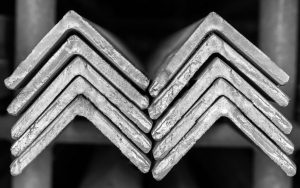
Stainless steel is one of the most versatile of all metals. Its demand continues to grow worldwide in large part due to advantages that stainless steel offers consumers, such as its increased formability, it’s easily welded, is corrosion resistance, has low maintenance, high strength, and has an overall attractive appearance. Once put into service, it does not need to be treated, coated or painted.
Stainless steels are iron-based alloys, essentially a low carbon steel, that contains at least 10.5% chromium. The addition of chromium gives the metal its corrosion-resistant, protective oxide layer. The characteristic oxide film gives this group of steels their unique properties—an ability to “heal” itself, so to speak, no matter how much of the metal’s surface is worn, deformed or removed.
The corrosion resistance and other useful properties of the steel are enhanced by increased chromium content and the addition of other elements such as molybdenum, nickel and nitrogen. There are more than 60 grades of stainless steel. However, three of the most popular grades are type 303 stainless steel, type 304 stainless steel, and type 316 stainless steel. All three are also austenitic. Austenitic steels are non-magnetic stainless steels that contain high levels of chromium and nickel and low levels of carbon. Known for their formability and resistance to corrosion, austenitic steels are the most widely used grade of stainless steel.
Type 303 Stainless Steel
Type 303 stainless steel is a non-magnetic, austenitic steel which is non-hardenable by heat treatment. Its basic composition is 18% chromium and 8% nickel stainless steel. In addition, it contains selenium or sulfur, which makes it highly machinable. Type 303 was designed to show improved machinability than other similar materials but also hold good mechanical and corrosion resistant properties. In fact, it is its sulfur content that makes it the most readily machineable of the austenitic stainless steel family. However, the sulfur decreases type 303’s corrosion resistance slightly, and its toughness, comparatively, it is still a very good choice for parts that are heavily machined. Nuts and bolts, aircraft fittings, gears, screws, shafts, electrical boxes, and bushings are all made with type 303 stainless steel for that purpose.
Type 304 Stainless Steel
The most popular stainless steel, type 304 accounts for over 50% of the stainless steel used worldwide. It not only provides high resistance to oxidization, but has exceptional corrosion resistance to chemical and atmospheric exposure. It’s also the most weldable of the austenitic stainless steels, which gives it an ease of fabrication and outstanding formability.
Type 304 stainless steel is widely used in a variety of household and commercial applications. You’ll find it most kitchen equipment, sinks, and appliances. It’s used for transport as chemical containers. Industrial grade food processing equipment, particularly in beer brewing, milk processing, and winemaking, all rely on type 304. It’s frequently used as an architectural trim and molding. It’s used in the mining industry to make woven or welded screens mining, quarrying, and water filtration. It’s a common structural design feature in the automotive and aerospace industry, as well as for construction material in buildings.
Type 316 Stainless Steel
The addition of 2% to 3% molybendum gives type 316 stainless steel increased resistance to corrosion and pitting. It is better suited for high chloride environments where structural pitting and crevices are more likely to occur. It performs at elevated temperatures, and is creep resistant, has excellent tensile strength, and outstanding formability and weldability. Type 316 stainless steel is found in heavy chloride environments like chemical processing and equipment, and in the marine industry in general, but specifically for boat fittings, valves and pump trim. It’s used in the pharmaceutical and textile industries; in condensers, evaporators and tanks, and food preparation equipment and systems. It can also be found in heat exchangers, laboratory benches, and equipment and pollution control equipment.
Atlantic Stainless is proud to offer a vast range of stainless steel grades, including 300 series, 400 series, 600 series, and much more. Feel free to browse our product catalog and, if you see something you are in the market for, request a quote from us today.

